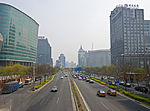Gate of Glorious Harmony
Buildings and structures in BeijingChina stubsForbidden City

The Gate of Glorious Harmony (simplified Chinese: 熙和门; traditional Chinese: 熙和門; Manchu: ᡳᠵᡳᠰᡥᡡᠨ ᡥᡡᠸᠠᠯᡳᠶᠠᠮᠪᡠᡵᡝ ᡩᡠᡴᠠ ijishūn hūwaliyambure duka), or the Gate of Xihe, Xihemen is a gate sits on the central road of the outer court of the Forbidden Palace. It is on the outer side of the Gate of Supreme Harmony, and eastern to the Gate of Blending Harmony It was first built on the 18th year of Yongle (1420) and was named Gate of Right Obedience. The current building is built on the 23rd year of Qianlong (1758).
Excerpt from the Wikipedia article Gate of Glorious Harmony (License: CC BY-SA 3.0, Authors, Images).Gate of Glorious Harmony
Gugong Dongmen Wai, Dongcheng District Donghuamen (首都功能核心区)
Geographical coordinates (GPS) Address Nearby Places Show on map
Geographical coordinates (GPS)
| Latitude | Longitude |
|---|---|
| N 39.914592 ° | E 116.395868 ° |
Address
故宫东门外
Gugong Dongmen Wai
100010 Dongcheng District, Donghuamen (首都功能核心区)
Beijing, China
Open on Google Maps










